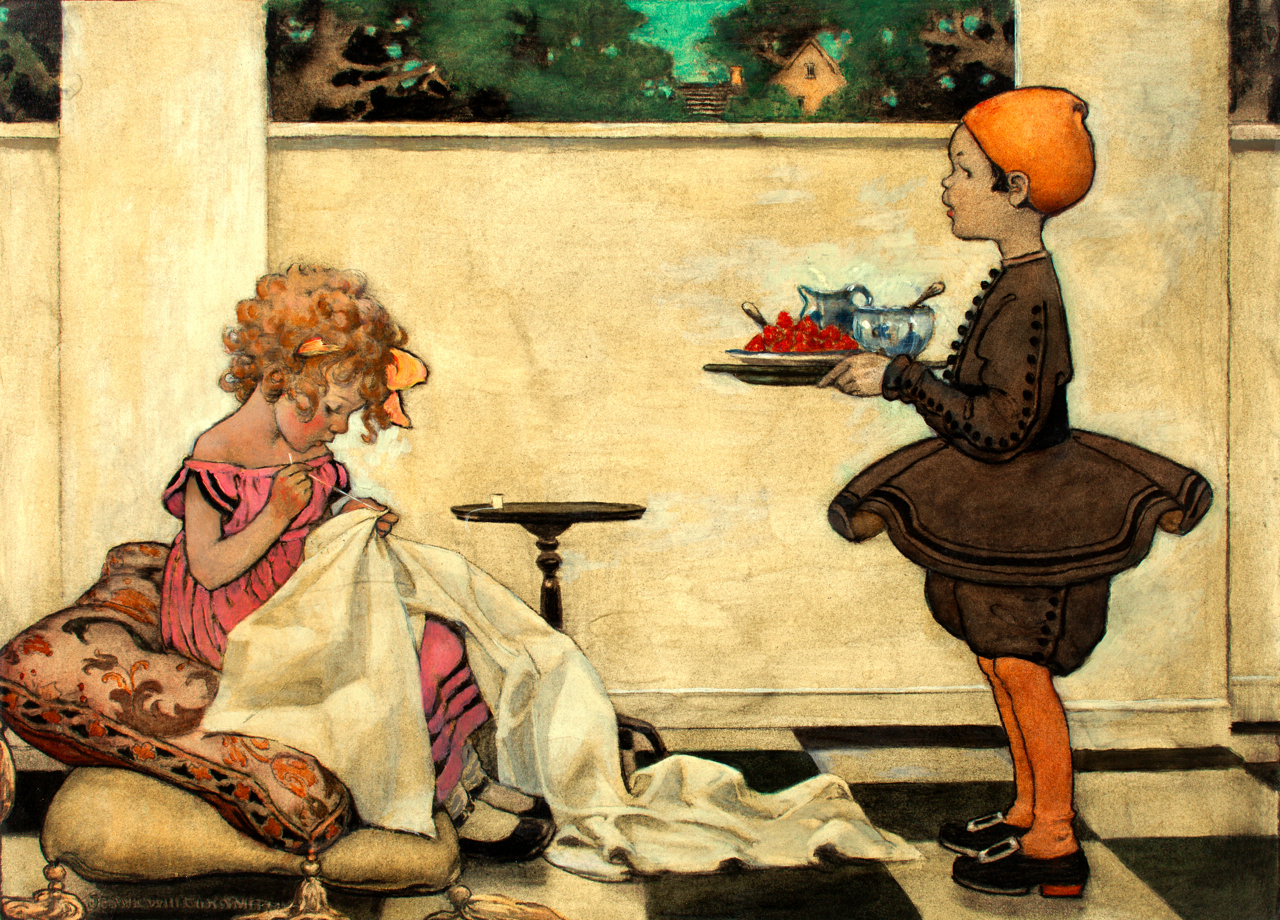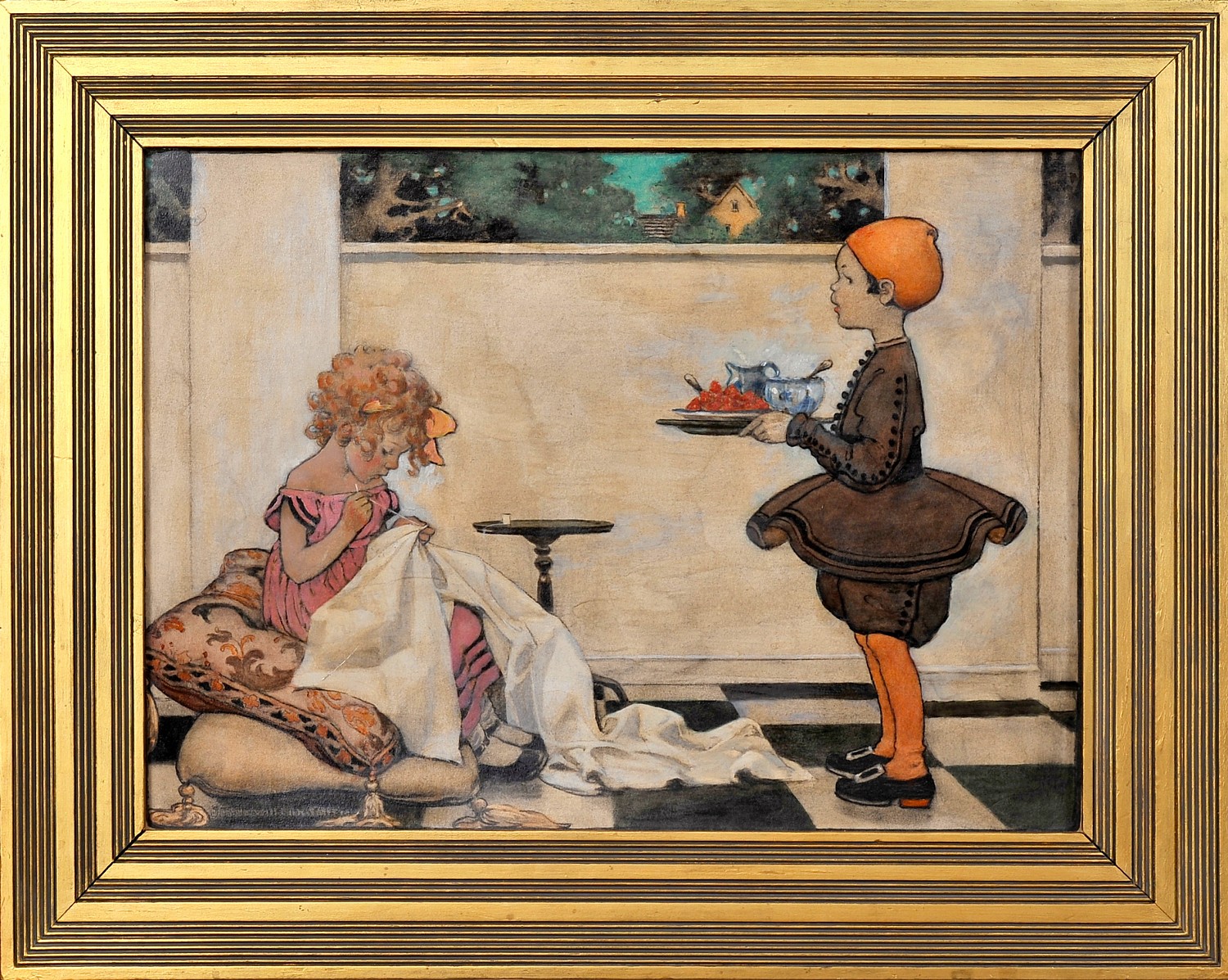"Curly Locks, Good Housekeeping Magazine" Lot no. 1052
By Jessie Willcox Smith (American- 1863-1935)
1914 (Estimated)
18.00" x 25.00", Framed 29.00" x 36.00"
Mixed Media on Board
Signed Lower Left
SOLD
SOLD
labeled "No. 2152 Good Housekeeping Magazine Illustration Mother Goose drawing 'Curly Locks' for January 1914", 18" x 25", in original frame under glass 26" x 33", signed LL. Also labeled "Frank W. Bayley, Copley Gallery, 103 Newbury Street, Boston.
Jessie Willcox Smith Painting Found
A painting stolen from the Proctor Free Library in Vermont is recovered at auction
On April 16, 2009, an interesting story popped up in the Rutland, Vermont newspaper. A long-forgotten painting found in a Proctor, Vermont attic sold for $96,600 at auction.
The artwork, titled “Curly Locks,” was painted by legendary illustrator Jessie Willcox Smith in 1914 for Good Housekeeping magazine. According to the story, the artwork was originally owned by three unnamed “spinster aunts” in Rutland. The eventual seller was given the work as a thank you by the last surviving aunt, whom she helped move into a retirement home. The seller, a woman who lived in Proctor, then put it in her attic for about 30 years, only pulling it out in 2009 for an appraisal that put its value at between $7,500 and $12,500.
Imagine her surprise when the dusty old painting sold through Kaminski Auctions in Beverly, Massachussets for over $96,000!
The resulting publicity raised the attention of a few knowl- edgeable individuals in Proctor, and it didn’t take long for the woman’s story to unravel.
It turns out that the Jessie Willcox Smith painting “Curly Locks” had been part of the Proctor Free Library’s collections since some time in the 1940s, and had occupied prominent places in the children’s section of the library over many years. As one of a series of paintings for Good Housekeeping’s Mother Goose series in 1914, the work had been a treasured conversa- tion piece.
Library Trustee vice president Stephen Follett was “shocked” to read in the Rutland Herald that an anonymous woman re- ceived the same painting from one of her spinster aunts years ago and decided to auction it off to help pay for her daughter’s wedding.
About a week after reading about the painting’s auction, Follett said the Board of Trustees had gleaned the truth— head librarian Mary Brough, who had worked for the library for about eight years, confessed to taking the painting. She was forced to resign but did not face criminal charges.
“The board voted unanimously not to pursue charges,” Follett said. “For my part, the reason was our primary interest was to get the painting back. She immediately confessed her involvement and we have the painting...as far as we’re concerned, it ends here.”
The State Police and Rutland County State’s Attorney James Mongeon followed suit.
After conducting an investigation that included interviews with members of the Board of Trustees and Brough, State Police Detective Sgt. Samuel Capogrossi said he brought the case to Mongeon. But after a meeting with the state’s attorney, the decision was made not to pursue charges.
“I don’t have a case,” Mongeon said. “You should talk to the Proctor Library, I can’t speak for them.”
The buyer and auction house were made financially whole. Brough had not taken receipt of the full amount from the sale. She had received only a small portion of it by the time the board and police caught on to the painting’s absence. What proceeds she did receive were all returned.
Follett, whose board was in the process of hiring a new librarian, said the painting will not return to the children’s section until it has been insured.
Exhibited: Christie's New York, Illustrating America: Norman Rockwell and His Contemporaries, November 30, 2013- January, 2014
Explore related art collections: Children / Magazine Stories / 1910s / Family / Food / Fashion / Brandywine School / $100,000 & Above / Women Artists
See all original artwork by Jessie Willcox Smith
ABOUT THE ARTIST
Jessie Wilcox Smith never married, but throughout her long career, specialized in drawing and painting mothers, babies and children. Her training was acquired at the School of Design for Women, the Pennsylvania Academy of the Fine Arts with Thomas Eakins, and at the Drexel Institute under Howard Pyle.
She had begun as a kindergarten teacher but turned to an art career with the stimulus and assistance of Howard Pyle. Some of her best-known illustrations were for books: Little Women, Heidi, A book of Old Stories and Robert Louis Stevenson's A Child's Garden of Verses. She also painted a great many illustrations for magazines such as Collier's and McClure's, and did nearly 200 covers for Good Housekeeping. For several years, she shared house and studio with two other Pyle students, Elizabeth Shippen Green and Violet Oakley. Working in close proximity they also strongly influenced eachother's work as well as that of several other Pyle - school women. This relationship is told in The Red Rose Girls by Alice Carter. Smith painted and exhibited widely, revieving many awards, a Silver Metal at the 1915 Panama-Pacific Exposition in San Francisco. She was also commissioned to paint many portraits of children.
Two other biographies, Jessie Wilcox Smith by S. Michael Schnessel, and Jessie Wilcox Smith American Illustrator by Edward D. Nudelman (who also contributed A bibliography) have been published.



